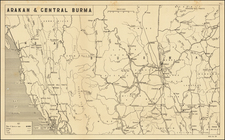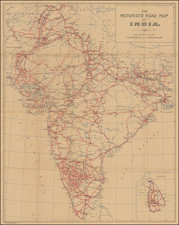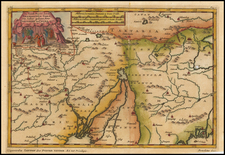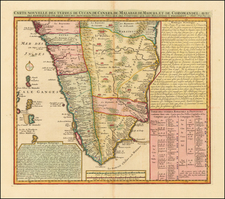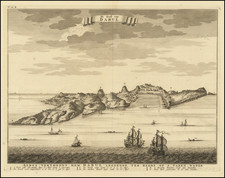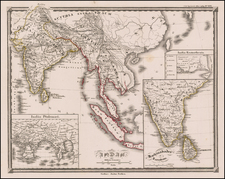A rare 1951 map illustrating the Le Corbusier design for Chandigarh, the new capital city of Punjab, India, one of the largest projects of his long career.
Scarce modernist urban masterplan for the proposed new capital city of Indian Punjab, executed by one of the most important architects of the 20th century, Le Corbusier.
When India was partitioned in 1947, the province of Punjab was split and the larger western part, including the capital at Lahore, went to Pakistan. The Indian government selected Chandigarh, at the base of the Himalayas, to be the site of a new capital, and in 1949 American architect Albert Mayer was commissioned to plan the city and design its architecture. Mayer stepped back from the project, and in early 1951, Le Corbusier was selected as his replacement. Le Corbusier's master plan, loosely interpreted in the map, was devised over four weeks from February to March 1951, with the first stage being the construction of government buildings and living accommodations for 150,000 inhabitants, and the second stage expanding housing to support 500,000.
The map splits the city into twenty sectors, each 800×1200 meters, with additional numbered labels for public and government buildings. Le Corbusier wrote in a letter to his wife in February 1951, “It will be a city of trees…of flowers and water, of houses as simple as those at the time of Homer, and of a few splendid edifices of the highest level of modernism, where the rules of mathematics will reign.” Le Corbusier’s intent is evident in the many green spaces on the map, illustrating the parks, open spaces, and park-like settings of schools, hospitals, community centers, and public swimming pools.
The more elaborate government buildings—le Corbusier’s “few splendid edifices”–can be seen at the northern edge of the city, including the High Court of Justice, constructed from 1951-1956, the Secretariat Building (1952-1958), and the Palace of Assembly (1952-1961). Corbusier placed the administrative complex on the outskirts of the city to expose politicians to rural areas—so they could recognize and improve upon the difficulties of rural life. One of the more striking aspects of the designs is the use of raw concrete whose surface had not been smoothed or polished.
Present-day assessments of Corbusier’s plan for Chandigarh vary greatly, with some arguing that it neglects core Indian values, while others view this as a strength, encouraging a more diverse and open-minded civic culture. One clear success is that Chandigarh is one of the cleanest cities in India—greatly thanks to the drainage system of Corbusier’s design—and is among India’s top cities in GDP per capita and living conditions. Unfortunately, not all of Le Corbusier’s planned green spaces were realized, and some view his prolific use of concrete as unappealing. In any event, in 2016 the city joined 16 other Le Corbusier projects as a UNESCO World Heritage Site.
We extend our thanks to Boston Rare Maps for the research and cataloging of this map.
Le Corbusier (Charles-Édouard Jeanneret, 1887-1965) was a pioneer of modern architecture, best known for the use of reinforced concrete buildings to meet the housing needs of growing urban populations. His career spanned five decades, and 17 of his architectural works are recognized by UNESCO as World Heritage sites. His work largely influenced the later Brutalist movement and has been both highly praised and savagely critiqued.
Corbusier’s embrace of concrete likely began with his apprenticeships under Auguste Perret, a pioneer of reinforced cement, between 1907-1910. In 1915, Corbusier conducted a study of reinforced concrete, finding that it was both an affordable solution to the lack of housing following the ravages of the First World War. He also found it to be extremely adaptable, capable of being worked into shapes not attainable with steel, wood or other existing structural materials.
Corbusier himself has also been a controversial figure. Some argue he displayed anti-Semitic and/or fascist leanings, though he never joined a fascist organization. Others critique his indifference to pre-existing architectural and other cultural norms. On the other hand, in his Le Corbusier: A Life, author Nicholas Fox Weber writes that “Le Corbusier was a combination of blind and naïve about all politics.”
Notations in the lower-left margin suggest that no fewer than 5000 copies of the map were printed in 1951, another 5000 in 1952, and 3001 in 1953. For all that, the map appears to be very rare, at least in the West: Including revisions of 1953 and 1954, I find a total of six institutional holdings in OCLC and no record of its having appeared on the antiquarian market. A disclosure is in order, however: At the time of writing I hold three examples, including two of the 1953 edition in comparable condition and one of the 1951 first edition in lesser condition but with provenance to John Reps, the noted Cornell scholar of urban cartography and planning.









